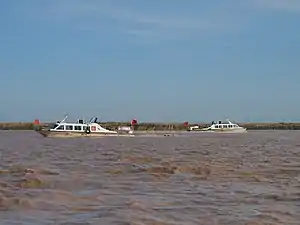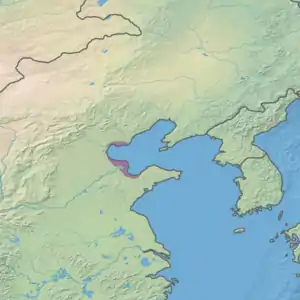Bohai Sea saline meadow
The Bohai Sea saline meadow ecoregion (WWF ID:PA0902) covers the coastal deltas of the Yellow River and the Luan River where they enter the Bohai Sea in China. The saline meadows and intertidal mudflats provide an important stopping-over point for birds migrating on the East Asian–Australasian Flyway. The region is under heavy ecological pressure from human development.[1][2]
| Ecoregion: Bohai Sea saline meadow | |
|---|---|
 Tourist Boats, Yellow River Delta, Bohai Bay | |
 Ecoregion territory (in purple) | |
| Ecology | |
| Realm | Palearctic |
| Biome | Flooded grasslands and savannas |
| Geography | |
| Area | 11,700 km2 (4,500 sq mi) |
| Country | China |
| Coordinates | 38°00′N 118°45′E |
Location and description
The ecoregion rims the crescent-shaped shore of Bohai Bay, on the northwest of the Bohai Sea. The river deltas are expanding from silt carried by the Yellow River from the loess soil regions to the west, and by the Luan River from the north.
Both natural and artificial wetlands are extensive in the region. The natural wetlands - reed fields and tidal flats - have diminished greatly in recent years through conversion to aquaculture and development. Artificial wetlands include paddy fields, salt fields, reservoirs and ponds.[3] A portion of the region is a Ramsar Convention wetland of international importance.[4] The Dongying-Huang He Nature Reserve is the area sits on the second largest oil-field in China.[1]
Climate
The climate of the ecoregion is Humid continental climate, hot summer (Köppen climate classification (Dwa)), with a dry winter. This climate is characterized by large seasonal temperature differentials and a hot summer (at least one month averaging over 22 °C (72 °F)), and cold winters having monthly precipitation less than one-tenth of the wettest summer month.[5][6] The average precipitation in the region is 592 mm/year, varying up to 20%.[4]
Flora and fauna
There are a wide variety local habitats, influenced by the interplay of fresh water and silt arriving by river with salt water pressure from the sea. The interior grasslands are characterized by Kunai grass (Imperata cylindrica), the saline meadows by salt-tolerate plants such as Suaeda. Freshwater stands inland have mostly been converted to rice paddies and aquaculture ponds.[1]
The region is an important migratory stop-over for the endangered Red-crowned crane (Red-crowned crane) and Siberian crane. The vulnerable Saunders's gull uses the region as one of its few breeding sites.[1] Biodiversity is high: scientists have recorded 367 species of bird, and 197 species of fish, in the Shadong delta alone.[4]
See also
References
- "Bohai Sea saline meadow". World Wildlife Federation (WWF). Retrieved December 28, 2019.
- "Map of Ecoregions 2017". Resolve, using WWF data. Retrieved September 14, 2019.
- "Bohai Sea - Environmental Risk Assessment". First Institute of Oceanography, State Oceanic Administration, China; Bohai Sea Environmental Management Project, People’s Republic of China; and GEF/UNDP/IMO Regional Programme on Partnerships in Environmental Management for the Seas of East Asia. Retrieved February 16, 2020.
- "Shandong Yellow River Delta Wetland". Ramsar Convention. Retrieved February 16, 2020.
- Kottek, M., J. Grieser, C. Beck, B. Rudolf, and F. Rubel, 2006. "World Map of Koppen-Geiger Climate Classification Updated" (PDF). Gebrüder Borntraeger 2006. Retrieved September 14, 2019.CS1 maint: multiple names: authors list (link)
- "Dataset - Koppen climate classifications". World Bank. Retrieved September 14, 2019.